The best definition for a Clean Agent is by NFPA 2001. It describes it as “a volatile or gaseous fire extinguishant that is electrically nonconducting and does not leave a residue upon evaporation.“
Forming part of the Montreal Protocol [substances that deplete the ozone layer], clean agents were introduced to replace ones such as Halon, which were noted as damaging to the environment and especially the ozone layer.
The name Clean Agent is derived from the way the chemical is designed to be less harmful to the environment and also that it leaves no residue upon evaporating, which, in the event of a discharge, helps with clearing up and reducing the time business operations are interrupted for, compared to a standard sprinkler/water-based system.
The four most common types of Clean Agent are:
- FM-200
- Novec 1230
- Inergen
- Argonite IG55
The agent is held as a liquid in a pressurized cylinder, designed to fight class A, B & C fires. When discharged through to the pipework and nozzles, it will change state to vapor due to its low boiling point, where it helps control the fire by absorbing heat from the space.
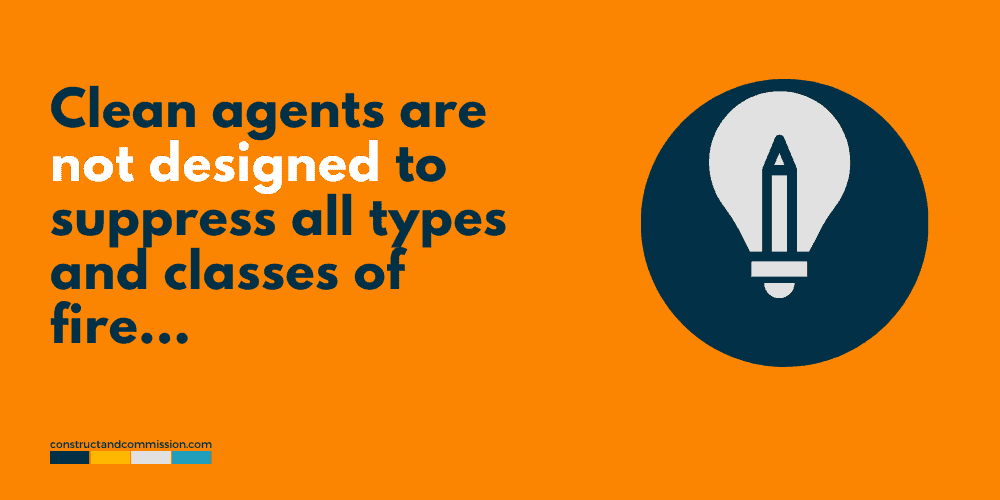
Clean agents are designed to fight what type of fires?
The datasheets for the different manufacturers need to be checked. Still, generally, the suppression system will be designed to extinguish Class A, B & C fires [USA], Class A, B, C & Electrical [UK], Class A, B, C, E [Australia].
There are some differences between them, as seen in the table below.
| Fire Classification | *United States [USA] | **United Kingdom / Europe [UK] / [EU] | Australia [Aus] |
|---|---|---|---|
| CLASS A | [Ordinary Combustibles] Wood, Paper, Fabric, Most Trash | [Ordinary Combustibles] Wood, Paper, Fabric, Most Trash | [Ordinary Combustibles] Wood, Paper, Fabric, Most Trash |
| CLASS B | [Flammable Liquid] Petroleum, Greases, Tars, Oils, Oil Base Paints, Solvents, Lacquers, Alcohols [Flammable Gases] | [Flammable Liquid] Petroleum, Greases, Tars, Oils, Oil Base Paints, Solvents, Lacquers, Alcohols | [Flammable Liquid] Petroleum, Greases, Tars, Oils, Oil Base Paints, Solvents, Lacquers, Alcohols |
| CLASS C | [Electrical] Energized Electrical Equipment, Electrical Appliances, Wiring, Cabling, Any risk of Electric Shock | [Flammable Gases] | [Flammable Gases] |
| CLASS E | [Electrical] Energized Electrical Equipment, Electrical Appliances, Wiring, Cabling, Any risk of Electric Shock |
||
| ELECTRICAL | [Electrical] Energized Electrical Equipment, Electrical Appliances, Wiring, Cabling, Any risk of Electric Shock |
References for the Fire Classifications:
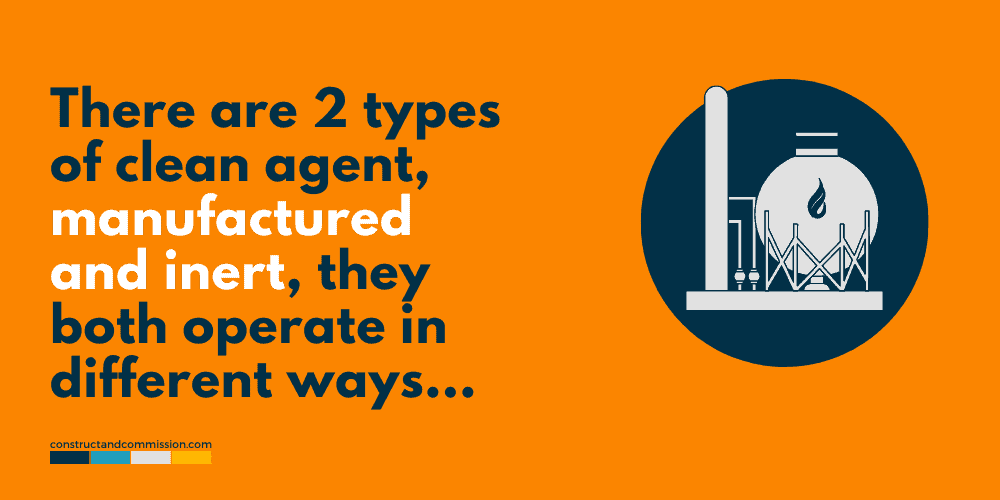
What are the 2 types of Clean Agents used?
When we think about Clean Agents, there are usually two types used:
- Manufacturered agents and,
- Inert agents
Manufacturered Agents
These are agents that have been created from 100% manufactured chemicals:
| Extinguishant | Manufacturer | Component | Formula |
|---|---|---|---|
| Novec 1230 [FK-5-1-12] | 3M | Dodecafluoro-2-methylpentan-3-one | CF3CF2C(O)CF(CF3)2 |
| FM-200 [HFC-227ea] | Ansul Chemours Fike Kiddie | Heptafluoropropane | CF3CHFCF3 |
Inert Agents
These are made up of the components of our breathable air ‘Nitrogen, Argon, CO2, Oxygen’ and consist of the following types:
| Extinguishant | Manufacturer | Component | Formula |
|---|---|---|---|
| Argonite [IG-55] | Kiddie | Nitrogen (50%) Argon (50%) | N2 Ar |
| N-100 [IG-100] | Kiddie | Nitrogen | N2 |
| Inergen [IG-541] | Ansul TYCO | Nitrogen (52%) Argon (40%) CO2 (8%) | N2 Ar CO2 |
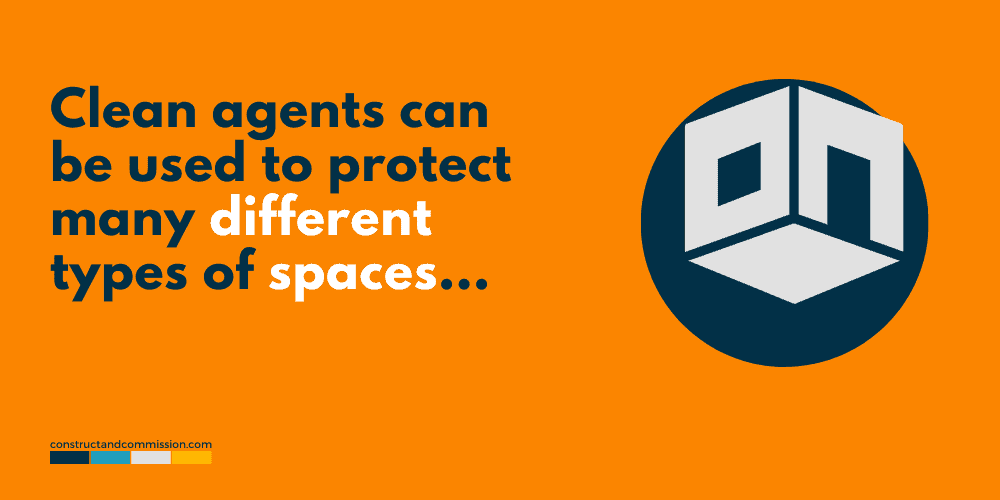
Where can Clean Agents Systems be used?
These systems are usually installed to protect critical equipment/spaces as they are fast-acting and, as long as the fire has been controlled quickly, do not cause that much damage to the room like a pre-action/sprinkler type system would.
Some locations we would generally find them are:
- Data Halls
- Server Rooms
- Telecom Roms
- UPS Rooms
- Switch Rooms
- Fuel Pump Rooms
- Libaries
- Museums
- Medical Facilities
- Industrial Applications
- Paint Booths
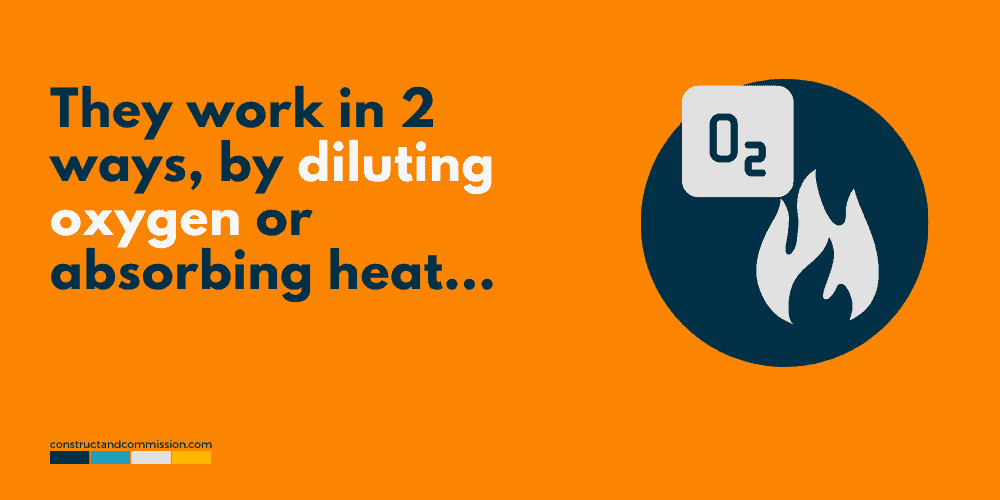
How they work?
Three things are needed to create a fire 1. Oxygen, 2. Heat, 3. Fuel [combustible material] is called the ‘Fire Triangle.’
Once a fire has started, one of the 3, (oxygen, heat, or fuel), will need to be removed, allowing the combustion process to be managed.
The element removed will depend on the type of agent being used in the space it is protecting.
The below table shows the different suppression types and what each controls:
| Suppression Type | Oxygen | Heat | Fuel |
|---|---|---|---|
| FM-200 | Lowers Temperature | ||
| Novec 1230 | Lowers Temperature | ||
| Inergen IG541 | Dilutes/Removes | ||
| Argonite IG55 | Dilutes/Removes | ||
| Nitrogen | Dilutes/Removes |
How does FM-200 Work?
FM-200, 1,1,1,2,3,3,3-Heptafluoropropane/HFC-227ea, is stored as a liquified compressed gas, in a cylinder; when the system activates, it does so extremely fast, releasing the liquid into the system, as it travels into the pipework, it changes state to a gas where it is then discharged into the protected space via specially designed nozzles.
The quantity of release will depend on the specific design requirements of the space and should always be specified by a qualified engineer.
If designed correctly, it is generally safe and non-toxic for humans but has the most impact on the environment, being it is an HFC.
To read more on the FM-200 System see our article FM200™ SYSTEM | What is it?
How does Novec 1230 Work?
Using a similar method to the above FM-200, Novec 1230, Dodecafluoro-2-methylpentan-3-one/ CF3CF2C(O)CF(CF3)2 controls and stops a fire by rapidly removing heat.
It is stored as a liquid, pressurized with Nitrogen, in a cylinder; when the system activates, it does so extremely fast, releasing the liquid into the system, as it travels into the pipework, it changes state to a gas where it is then discharged into the protected space via specially designed nozzles.
The quantity of release will depend on the specific design requirements of the space and should always be specified by a qualified engineer.
Some impact the environment, but not as much as the FM-200 System. If designed correctly, humans should still breathe within the protected space and is generally considered the safest to use in occupied spaces.
How does Inergen Work?
As a suppressing agent, Inergen is made up of natural gases [Nitrogen, argon, CO2]. It is designed to control and suppress the combustion process by diluting the oxygen in the space below that is needed to start a fire, around 16%.
The quantity of release will depend on the specific design requirements of the space and should always be specified by a qualified engineer. Inergen will generally react slower and need more suppressant and floor space than a similar type system using FM-200/Novec.
Limited impact to the environment due to the use of natural gases, and if designed correctly, humans should be able to still breathe within the protected space.
How does Argonite IG55 Work?
Using a similar method to the Inergen System above, Argonite comprises natural gasses [Argon and Nitrogen]. It controls a fire by diluting the oxygen in the space to below 16%.
The quantity of release will depend on the specific design requirements of the space and should always be specified by a qualified engineer.
Limited impact to the environment due to the use of natural gases, and if designed correctly, humans should be able to still breathe within the protected space.
How does Nitrogen Fire Suppression Work?
Using a similar method to the Argonite and Inergen Systems above, Nitrogen is made up of natural gasses [Nitrogen]. It controls a fire by diluting the oxygen in the space to below 16%.
The quantity of release will depend on the specific design requirements of the space and should always be specified by a qualified engineer.
Limited impact to the environment due to the use of natural gases, and if designed correctly, humans should be able to still breathe within the protected space.
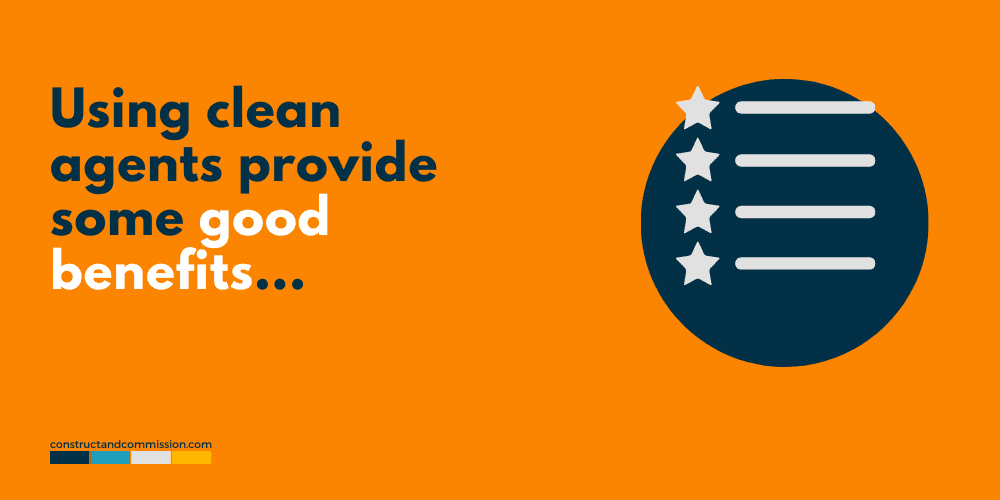
Clean Agent Benefits
Clean Agents have several benefits over the typical wet type system and should be considered and implemented to protect critical spaces, equipment, and materials.
- Easy to install
- Easy to maintain
- Fast acting
- Minimal down time to business activities
- Less damage and replacement of materials and equipment
- Limited cleanup after activation than compared to a wet system
- Require less floor space than a typical wet system with tanks and pumps
- Selecting the correct one has little to no impact on the environment
- Safe for occupied areas
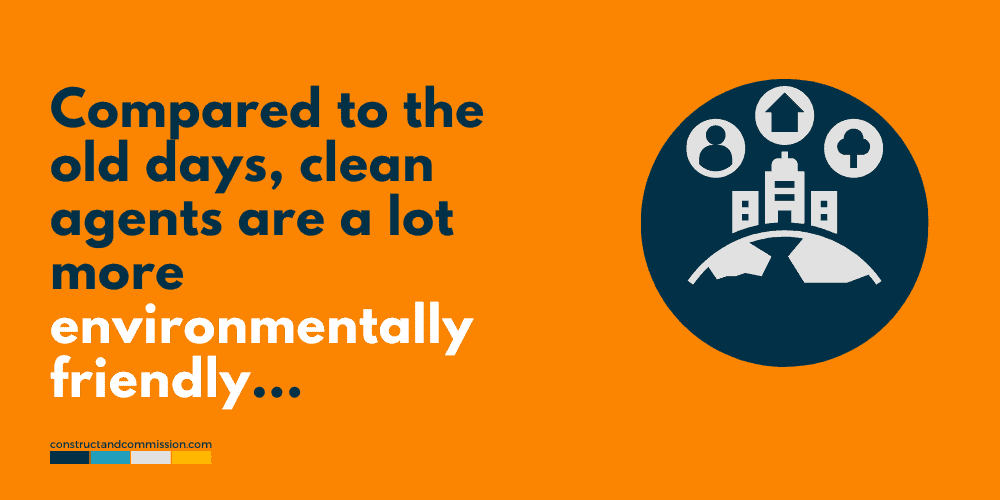
Are they Environmentally Friendly
Choosing the right agent to use will ensure that they are not causing issues with the environment, the safety of operatives/staff, and being corrosive to equipment and materials.
Clean Agents are safe for the environment, deemed zero ozone-depleting, non-toxic to humans, and not corrosive. This makes them ideal to use.
Before using these, Halon was broadly installed and used, which was discovered to have a severe impact on the earth’s ozone layer. Halon has been phased out and can now only use it if reclaimed or from existing supplies; none can be manufactured.
⬛ Related Articles
GASEOUS/FM200 SYSTEM | Functional Testing Template & Download
FM200™ SYSTEM | What is it?
CLEAN AGENT | Room Integrity Testing Requirements
GAS SUPPRESSION / FM 200 SYSTEM | Pre-Functional Checklist
FM200™ SYSTEM | Pipework Pressure & Puff Test Template
FIRE SPRINKLER SYSTEMS | 4 Types Explained

